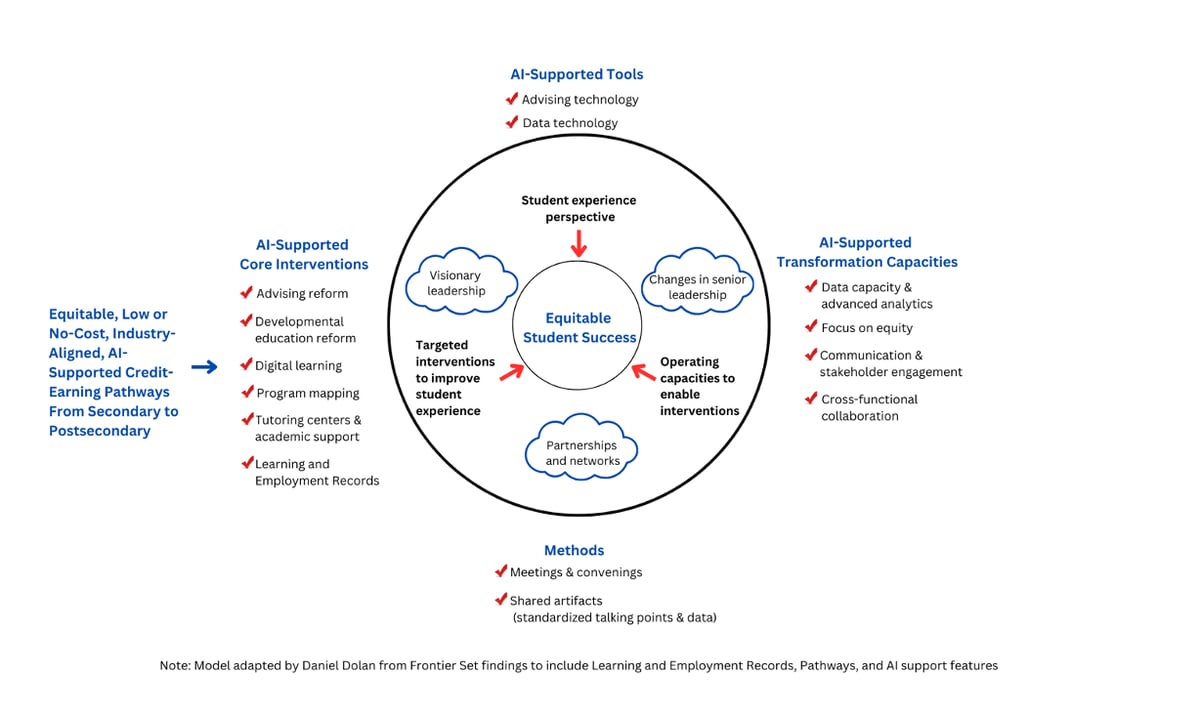Published on
An Evidence-Based Model for AI-Supported Equitable Postsecondary Transformation

Postsecondary institutions must transform to become more focused on equitable AI-supported, industry-aligned learner success.
The U.S. postsecondary (higher education) value proposition is inequitably experienced, broken or unattainable for many individuals who wish to tap into that value to gain increased financial stability and more fulfilling futures. We have identified most of the problems through studies, and many organizations and government agencies are funding projects to remedy or at least mitigate some of the most visible or manageable challenges.
But most of the dysfunction in the postsecondary experience is entrenched within historically accepted practices that prioritize institutional comfort and security over the complex constellation of learner success needs. Enrollment and persistence data, particularly during and postpandemic, show that this institution-first postsecondary culture is no longer viable.
Equitable postsecondary transformation is required. I define equity in the context of postsecondary transformation as “the intentional, institutional pursuit of a state where race and socioeconomic status are no longer entrenched and reliable predictors of student experiences and outcomes,” and I define transformation here as “the realignment of an institution’s structures, culture, and their business model to create a student experience that results in dramatic and equitable increases in outcomes and educational value” (Frontier Set site).
Transformation-aligned organizations are collaborating to forge solutions, and rapid advances in AI technologies and capabilities show great promise for supporting postsecondary transformation. So, in this essay I propose an evidence-based model for equitable AI-supported postsecondary transformation to attempt to pull together key findings in a visual map that might serve as a guide for policymakers, postsecondary institutions, and intermediaries working on transformation activities. This model is not prescriptive, although I believe that centering equity should be non-negotiable. Rather, I hope the model might inspire conversations, new transformation strategies or development of other transformation models to guide action in response to new evidence and evolving AI tools.
Postsecondary Learning Drives Economic and Noneconomic Value for Individuals and Society
Postsecondary education—defined here as any formally credentialed learning experience beyond high school—has multiple empirically confirmed positive outcomes.
According to the World Bank, “Globally, there is a 9% increase in hourly earnings for every extra year of schooling. For societies, it drives long-term economic growth, spurs innovation, strengthens institutions, and fosters social cohesion.” In the United States, an August 2023 Gallup-Lumina report found a meaningful, positive statistical relationship (although not necessarily a direct causal relationship) between postsecondary education and 50 of 52 economic and noneconomic outcomes including “higher income, better health status, better wellbeing, increased likelihood to do work that fits with their natural talents and interest, voting participation, volunteerism and charitable giving” (p. 3).
Inequitable Value
But learners don’t equally realize all the benefits of postsecondary learning. As the Defining Value section of the May 2021 Postsecondary Value Commission report website points out, “Measuring the returns students and society receive from investing in education after high school starts with being clear about what those returns are and who receives them … students experience postsecondary value when provided equitable access and support to complete quality, affordable credentials that offer economic mobility and prepare them to advance racial and economic justice in our society.” Yet the report found that “troubling disparities in access to these opportunities exist by race/ethnicity, socioeconomic status, and gender” (p. 8).
Equitable Postsecondary Transformation Is Required
Postsecondary learning opportunities and outcomes have for many years been failing many students in the United States. The challenges are so significant that small fixes cannot repair the structural corrosion that continues to weaken higher education’s promise to create opportunities for livable wages and more fulfilling lives for all individuals, meet employers’ demands for skilled workers and strengthen democratic civic institutions.
Existing and entrenched models must be transformed across the entire postsecondary ecosystem.
Meanwhile, rapid advances in AI technologies and tools suggest possibilities for supporting postsecondary transformation with carefully curated, non-biased AI tools across institutional processes and activities to drive efficiencies and reduce inequities. Surprisingly, however, Inside Higher Ed’s 2023 Survey of Campus Chief Technology/Information Officers found that only 16% of 140 CIOs surveyed see investing in AI as “essential” or a “high priority” for their college or university. The survey also found that these postsecondary tech leaders’ reticence to roll out AI tools is due mostly to concerns about data security and ethics.
Certainly, how we leverage these powerful AI tools to support postsecondary success matters. I argue that, in addition to ensuring that AI tools are unbiased and honor data privacy and security for all stakeholders, AI-supported postsecondary transformation must center equity as both a fundamental value and as an essential and non-negotiable feature of all transformation goals, practices and metrics.
In this essay, I introduce a model for equitable AI-supported postsecondary transformation. But before we work on a new model to fix what is broken in postsecondary institutions, first we should examine exactly how current postsecondary systems and practices are failing so many learners.
Postsecondary Corrosion: Inequity in Access, Completion and Outcomes
Evidence of systemic postsecondary barriers to enrollment and completion for all unenrolled and enrolled adults as well as inequities in access, belonging and outcomes are clear. First, National Student Clearinghouse Research Center data show that postsecondary enrollments overall keep sliding. Although community college enrollment in spring 2023 grew a slight 0.5% since spring 2022, undergraduate enrollment at public and private four-year institutions continues its long decline, with 0.5% fewer public and 0.2% fewer private school enrollments in spring 2023.
The Lumina Foundation-Gallup State of Higher Education 2023 study highlights details of these challenges:
Unenrolled adults face inequitable challenges to enrolling
Among unenrolled adults, 47% report having considered enrolling in some kind of postsecondary credential program. Financial challenges, including program costs (55%), inflation (45%), and pressure to work (38%), are the key reason for not enrolling. For unenrolled Black and Hispanic adults, additional challenges including childcare demands keep them from enrolling.
Staying enrolled is more difficult for Hispanic and Black students
“Remaining enrolled was about as difficult for students in 2022 as it was in 2021. Forty-one percent of students in 2022 said it was ‘very difficult’ or ‘difficult’ for them to remain in their programs, similar to the 39% who said so in 2021” (p. 5). The top three reasons that students considered stopping out of postsecondary learning in 2022 were (1) emotional stress, (2) personal mental health and (3) cost.
But 50% of Hispanic students—more than any other race—struggled to stay enrolled in postsecondary learning programs. This statistic is especially true of male Hispanic students. Forty percent of Black students reported having difficulty staying enrolled, followed by 37% of white students. The percentage of enrolled students who have considered stopping out increased from 37% in 2021 to 41% in 2022. Hispanic (52%) and Black (43%) students are most at risk—and those risks are increasing. In 2021, 44% of Hispanic and 37% of Black students considered stopping out.
Student loan debt is preventing Black and Hispanic students who have stopped out from re-enrolling
Half of students in 2022 had student loan debt averaging $38,000. “Forty-seven percent of students who stopped their postsecondary education before finishing say they would be very likely to re-enroll if some or all of their student loans were forgiven. The proportions are higher among Black (57%) and Hispanic (49%) adults who have stopped out than among white adults (37%)” (p. 34).
Hispanic and Black students are more likely to report feeling unsafe
The Lumina Foundation-Gallup State of Higher Education 2022 study found that Hispanic students “were also more likely than students of other races to feel discriminated against, harassed, disrespected, and physically and psychologically unsafe at their institutions.” 25% of Hispanic students reported being negatively impacted by these feelings frequently or occasionally, with Black students at 20%.
An Evidence-Based Model for Equitable AI-Supported Postsecondary Transformation
We know that postsecondary learning has great value, that almost half of all unenrolled adults want to enroll but do not due to various challenges and that about two out of five students struggle to remain enrolled—with Hispanic and Black students struggling most.
Now we need to work urgently and collaboratively to secure the promise of equitable postsecondary success for as many people as possible.
The model I propose here is based on postsecondary transformation findings gleaned from site visits to participating institutions and data from the Frontier Set initiative (2015–2021) funded and organized by the Bill and Melinda Gates Foundation and adapted to include pathways as described in the Accelerate ED initiative, digital learning and employment records as advocated by the T3 Network, and AI support features. The Frontier Set initiative consisted of “a select group of [29] high-performing, high-potential colleges, universities, state systems, and supporting organizations committed to eliminating race, ethnicity, and income as predictors of student success by transforming how institutions operate” (Frontier Set site).
The model recognizes that “transformation is a journey, along which incremental changes to the way an institution operates allow that institution to continuously improve and align its policies and practices to better serve students” (Frontier Set site). From this journey perspective, the model is intended to spark collaborative conversations and transformation projects that align with an institution’s unique context, culture and operations without being prescriptive.

How to Read the Model
The core rationale for the model and for postsecondary transformation is equitable student success, which is shown appropriately at the center of the model. Student success is considered equitable when “parity in educational outcomes is prioritized and communicated in an institution’s mission, explicit in strategic plans, and measured using disaggregated student data” (Frontier Set site).
The model supports equitable student success (see red arrows) through three key institutional features identified in Frontier Set findings as being consistent across many institutions: (1) a student experience perspective: “mapping the student experience to identify barriers and chart a clear path from matriculation to completion;” (2) targeted interventions to improve the student experience: “implement evidence-based solutions that measurably improve the student experience;” and (3) operating capacities to enable interventions: “strengthen structures and routines that enable effective implementation, tracking, and improvement of targeted interventions” (Frontier Set site). These three key features are sustained by three internal institutional catalysts: (1) visionary leadership; (2) changes in senior leadership that might “bring a student-centered agenda, have an opportunity to build on previous efforts, or act on a mandate to change the status quo;” and (3) partnerships and networks “that support data-driven decision-making and sharing of best practices for institutional reform” (Frontier Set site).
Moving outside the model’s outer ring, we find four components associated with transformation at most Frontier Set institutions, with AI-supported features for three of the four components added by me: (1) AI-supported tools: “technology, software, and platforms that support an institution’s transformation model;” (2) AI-supported transformation capacities: “an institution’s operating capacities and campus-wide engagements that enable change by creating the conditions necessary for transformation;” (3) AI-supported core interventions: “an institution’s targeted interventions and initiatives that quicken the pace of change, resulting in improved student success outcomes;” and (4) methods: “institutional practices, processes, and structures that support transformation” (Frontier Set site).
Finally, equitably designed and AI-supported learning and credit-earning pathways from secondary to postsecondary that ideally result in completion of an associate degree by year 13 can accelerate meaningful employment or transfer to a four-year postsecondary program.
Conclusion
I believe that equitable postsecondary transformation requires that senior leaders at postsecondary institutions recognize that transformation journeys will promote not only student success but also institutional success. Institution incentives must align with the commitment to equitable transformation.
If all postsecondary institutions and intermediaries including federal, state and local governments, employers, and other aligned actors embrace learner-centered equitable transformation as the postsecondary ecosystem’s key mission and demonstrate this commitment collaboratively and transparently in all policies, plans, decisions and activities—leveraging evolving AI technologies and tools in support of this mission—we can dramatically increase attainment of postsecondary success for all individuals who choose this path.


